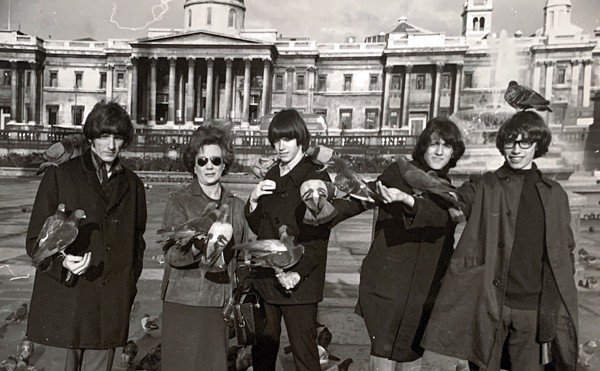Among the core members of this scene was one Lemmy Kilmister, whose band Motörhead was one of the first heavy-metal bands and among very few that appealed both to cow-molesting heshers and scabies-infested punkers. His passion for slutty women drove him to a career in rock & roll, and his speed-snorting-and-groupie-devouring story is a good one.
In White Line Fever, Lemmy lets fly with a sense of humor that's very dry and British, regaling readers with the usual tales of rock excess: trashing hotel suites, getting busted for drugs and fathering and abandoning children. Lemmy was trippin' out in the '60s, spent time as a roadie for Jimi Hendrix, toured the United States with Hawkwind and was around for the very beginning of punk, attempting to give Sid Vicious bass lessons and briefly playing with The Damned. Hyping Motörhead, Lemmy told Sounds magazine in 1975, "It will be the dirtiest rock & roll band in the world. If we moved in next door, the lawn would die." Motörhead went on to top the charts in England. Lemmy blabs incessantly about the virtues of every Motörhead album and also does a lot of whining about wicked managers and unsupportive labels. But not every Motörhead record deserves comment, and White Line Fever could have benefited from a good editor, who would've removed the constant griping. Lemmy's life story should have been condensed and the book's writing spiced up. A more entertaining read in the same vein is Neil Strauss' Mötley Crüe tell-all, The Dirt, which is nastier and livelier than White Line Fever.
Aside from tales of rock glory from various exalted party animals, there are a variety of books that tackle the whole bloody history of heavy metal. Professor of sociology Deena Weinstein's Heavy Metal: The Music and Its Culture took the college thesis route and might bore the leather pants off many headbangers. Rock critic Chuck Eddy's Stairway to Hell: The 500 Best Heavy Metal Albums in the Universe is a very individualistic, somewhat nutso take on the genre. Eddy left Judas Priest and Iron Maiden off his metal list in favor of forgotten glam bands like Kix, who are near the top of the list, and various punk, funk and New Wave acts that no one else would consider metal.
Coming from a true metal-dude perspective and covering the most arcane foreign scenes and subgenres, Ian Christe's Sound of the Beast: The Complete Headbanging History of Heavy Metal may be the ultimate metal tome. Christe writes in an ornate style, as if he's composing Iron Maiden lyrics. He writes, "As ordained by Black Sabbath, heavy metal was a complex maelstrom of neurosis and desire. Formed into an unbending force of deceptive simplicity, it had an omnivorous appetite for life." Recently released in a very affordable updated paperback edition ($13.95), Sound of the Beast begins with the story of Black Sabbath told just as it should be -- with charming bombast. Christe also extensively covers the humble beginnings of Metallica and its long, slow rise to rock domination, launched when Danish metal zealot Lars Ulrich, a former ranked teen tennis player, began jamming with James Hetfield, who had grown up with a screwy family of Christian Scientists. When Hetfield's mom died of cancer in 1979 after refusing medical care, Hetfield quickly became a metal miscreant who shoplifted from drugstores and played with the bands Phantom Lord and Leather Charm. Following the recording of their crude, brutal debut, Kill 'Em All, the members of Metallica seriously considered shifting Hetfield to rhythm guitar and replacing him with a more conventional vocalist like John Bush of Armored Saint, who passed on the gig.
Sound of the Beast bulges with this sort of engaging trivia. Who knew that Rob Halford borrowed ideas from Sun-Tzu and Shakespeare to compose the lyrics on Sad Wings of Destiny; or that several bands from the Florida death-metal scene wore sweatpants onstage, which European metalers ridiculed as "retirement wear"; or that "Am I Going Insane?" was a moment of clarity for Ozzy Osbourne after he supposedly spent 1972 through 1974 on acid?
Like the editors of Spin, Christe has discovered that rock lists are fun, and includes pages of them, including "Most Likely to Mention Their Own Band Name in a Song," "Headbanging Born-Agains," "Weirdest Metal Stage Acts" and "Shamelessly Weak False Metal Anthems." While Christe is undoubtedly an expert on metal's formative years, he has also composed detailed chapters on the Tampa Bay death metal scene, the speedier-than-thou grind-core phenomenon and the satanic black metal movement from Scandinavia. (If you're craving more detail on black-metal mayhem, have a look at Michael Moynihan's Lords of Chaos, which relates the whole, murderous story.)
Naturally, like a true acolyte of the scene, Christe pooh-poohs KISS as bubblegum rock and trashes the late '80s glam fad. He spends a couple of pages dismissing punk rock as a fashion statement and makes clear that all of the above were inferior to the mightiest band of them all: Black Sabbath.
That may seem a bit ridiculous, but at the same time, it's so heavy metal.





